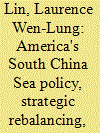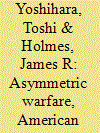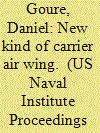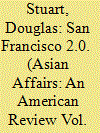| Srl | Item |
| 1 |
ID:
126134


|
|
|
|
|
| Publication |
2013.
|
| Summary/Abstract |
The US South China Sea policy is designed to deny power transition in the Asia-Pacific. Strategic rebalancing has become America's Asia-Pacific Strategy for reassuring hegemonic stability and supporting its South China Sea policy. Practically, strategic rebalancing depends heavily upon naval diplomacy. As a result of us naval diplomacy, the DOC (Declaration on the Conduct of Parties in the South China Sea)-symbolized "ASEAN+China" mechanism is being eroded by the looming US-dominated neo-realistic framework, an indication that Washington's strategic rebalancing has secured preliminary success. Yet, the creditability of US naval diplomacy in the South China Sea ultimately rests upon the progress of the Navy's maritime strategy in the Asia-Pacific. Michael Mullen's idea of "landward push" of sea control resides at the core of the 2007 Maritime Strategy, of which the core operational mechanism is the Navy Expeditionary Combat Command (NECC). NECC is key to the AirSea Battle concept and naval diplomacy. The 2012 and 2013 Balikatan exercises have showcased the utilities of NECC and provided much edification: with the use of versatile naval diplomacy, the US Navy has insinuated Mullen's idea into the South China Sea, advanced AirSea Battle, facilitated strategic rebalancing, and reassured its South China Sea policy. If China fails to fully comprehend the progress of America's maritime strategy, it may end up wrestling with a far superior balancing coalition that is being created by the US.
|
|
|
|
|
|
|
|
|
|
|
|
|
|
|
|
| 2 |
ID:
130287


|
|
|
| 3 |
ID:
140563


|
|
|
|
|
| Summary/Abstract |
AirSea Battle (ASB) has generated significant publicity, controversy, and debate among scholars, analysts, commentators, and observers of US defense strategy. However, a research gap exists concerning formal analysis of the impact of the operational concept on the relationship between the US Air Force (USAF) and the US Navy (USN). The impact of the ASB operational concept on the USAF–USN relationship is examined across the issue areas of strategy, budgets, weapons procurement, and training. These four issue areas represent important areas of historical conflict and competition between the Air Force and Navy. The conclusion is that ASB is ushering in a new era of Air Force–Navy partnership that advances the inter-service dynamic from “jointness” toward integration. The emergent USAF–USN partnership therefore represents a significant development in US defense politics and defense strategy.
|
|
|
|
|
|
|
|
|
|
|
|
|
|
|
|
| 4 |
ID:
124045


|
|
|
|
|
| Publication |
2012.
|
| Summary/Abstract |
What types of aircraft will be deployed on tomorrow's flattops?
|
|
|
|
|
|
|
|
|
|
|
|
|
|
|
|
| 5 |
ID:
117651


|
|
|
|
|
| Publication |
2012.
|
| Summary/Abstract |
This is the third time that American policy makers have considered a pivot to Asia. This time is different, however, because it is clear that the base of gravity of the global economy is shifting from West to East. As the most powerful nation in the Asia-Pacific, the United States has an overriding national interest in the preservation of regional prosperity and order. But Washington recognizes that it can no longer impose solutions on the major governments in the region. A new U.S. strategy for the Asia-Pacific will have to take into account the very strict limits imposed on U.S. foreign and defense policies by America's relative economic decline. This means that Washington will have to convince its friends and allies to take greater responsibility for regional security. The so-called San Francisco system of U.S.-sponsored alliances will have to be transformed, in order to make it more responsive to the problems that confront America and its regional friends and allies. This essay will draw upon Joseph Nye's concept of ideal and material resources to assess the viability and adaptability of the San Francisco system. It will also consider the merits of the Pentagon's proposed AirSea Battle concept as a response to Chinese military modernization and as a source of reassurance for Washington's regional friends and allies.
|
|
|
|
|
|
|
|
|
|
|
|
|
|
|
|